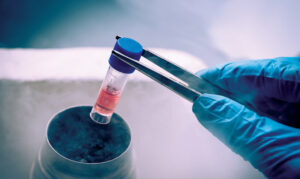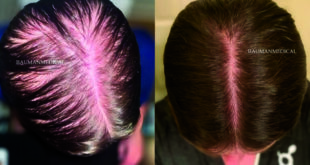By: Regenexx at Gold Coast Orthopedics and Regenerative Medicine
 Utilizing birth tissues to harvest stem cells for orthopedic and other areas of medicine is an exciting topic. However, there are currently no FDA-approved uses for allogeneic (coming from someone else) stem cell products other than cord blood or bone marrow transplantations after certain kinds of cancer treatments. More disturbing is the fact that vials of amniotic, placental, and umbilical “stem cells” that sales reps are selling to many physicians DO NOT contain living stem cells. This has been independently tested and confirmed by major universities and Regenexx. We urge patients to arm themselves with knowledge against these deceptive claims.
Utilizing birth tissues to harvest stem cells for orthopedic and other areas of medicine is an exciting topic. However, there are currently no FDA-approved uses for allogeneic (coming from someone else) stem cell products other than cord blood or bone marrow transplantations after certain kinds of cancer treatments. More disturbing is the fact that vials of amniotic, placental, and umbilical “stem cells” that sales reps are selling to many physicians DO NOT contain living stem cells. This has been independently tested and confirmed by major universities and Regenexx. We urge patients to arm themselves with knowledge against these deceptive claims.
What are amniotic, placental, and umbilical tissue-based products?
As you may know, babies, while still in the womb, are encased in a fluid-filled sac known as the amniotic membrane. Following the birth of a child, the amniotic membrane and/or fluid can be collected, sterilized, and processed into a variety of tissue- based products. Placental and umbilical tissue can also be obtained for the same purpose. Regrettably, these products are being pitched and sold to doctors as “stem cell” products. Some of these products do contain growth factors that can stimulate stem cells when injected into one’s tissues. However, it is NOT accurate to call them stem cell products. Legally, representatives shouldn’t be making these claims to physicians and in-turn physicians should not be making these claims to patients.
Are there stem cells in these tissues?
There are in fact stem cells in these tissues at the time of birth. However, once the tissues are processed, the cells are sterilized (killed). If these products did contain stem cells, the product would be classified as a drug by the FDA, requiring approval before being used in human clinical trials. It would not be marketable until clinical trials for each indication were completed and the drug was determined to provide benefits that outweigh its potential risks. This takes many years and can cost $1 billion or more. No wonder some unscrupulous companies want to bypass this process. The FDA has issued enforcement letters to companies selling unapproved products stating that their products are regulated as drugs. However, until now, the FDA has only enforced these rules sporadically expecting that the industry would regulate Itself. Unfortunately, companies knowing the FDA has stated that they won’t get aggressive with enforcement until Nov. 2020, have flourished.
To clarify, either these companies are selling an illegal unapproved drug or more likely, as confirmed by testing, selling dead tissue products that they claim have living stem cells. Both of these scenarios are problematic.
What else does amniotic fluid contain?
Processed amniotic fluid does retain some growth factors and cytokines that can be injected to help promote healing. But, before spending thousands of dollars on a vial of these products, you may want to consider another alternative. At this time, there is no data supporting that the use of these tissue products is better than your own platelet-rich plasma (PRP). PRP contains your own healing growth factors, is not nearly as expensive, and is easier to obtain. PRP is an excellent option that likely accomplishes the same thing, if not better than, a vial of amniotic fluid for a fraction of the price.
Why are sales reps pushing amniotic, placental, and umbilical “stem cells”?
Expensive vials of these tissue-based products represent a scalable, one-size-fits-all product that aligns with the pharmaceutical industry’s traditional mass marketing business plan. On the other hand, PRP requires a doctor’s office to take blood from the patient and process it into a growth factor-rich therapeutic. Because the PRP comes from the patient’s own blood, this eliminates any possibility of bodily rejection. If processed correctly, it can also be customized to the needs of the specific patient. So why are sales reps pushing ready-to-inject vials? For many providers, PRP is inconvenient and time-consuming. Also, most providers probably believe they are using live “stem cells” because they believe what they are being told. Unless a physician has access to state-of- the-art labs to fully investigate a product, they must rely upon sales pitches that are potentially full of deceptive claims.
How do you know these vials contain no stem cells?
If these products ‘did contain living stem cells and were approved by the FDA, Regenexx would have signed on to become one of the biggest customers. The reality is that we have conducted lab research, determined the validity of these claims, and uncovered deception. Research scientists at Regenexx and the Interventional Orthopedics Foundation (IOF) were the first to begin testing these claims. Other academic research labs have since validated the initial findings -that is the results concluded that there were no living cells in these products, the products didn’t help older stem cell performance, and didn’t contain more growth factors than a PRP injection.
Regenexx has published a large percent of all orthopedic stem cell research worldwide, has the world’s largest database patient registry tracking outcomes and safety, and is the only protocol when delivered by certified Regenexx physicians, that is receiving insurance coverage by self-insured employers across the country (>7 million covered lives).
Knowledge is power. The marketing of amniotic, placental, and umbilical “stem cells” has been misleading at best. Even though we may be able to justify using them for their growth factors, the reality is that your own PRP or concentrated bone marrow (compliant with FDA regulations) is likely a better overall treatment option.
Evan Musman, DO is a non-surgical orthopedic physician who completed his anesthesio-logy residency at the Albert Einstein College of Medicine in 1994. After training, he stayed at AECOM and served as an Attending in Anesthesiology instructing residents and focu-sed on Pain Medicine. He then joined a private practice in Connecticut where he served as the Medical Director of the Johnson Ambulatory Surgical Center and treated complex pain patients. He continued his northward migration and opened Vermont Pain Management, the first, free-standing interventional pain management practice in the state. He was the President of the Vermont Society of Interventional Pain Physicians for over 10 years. After over 25 years of practice, Dr. Musman became increasingly dissatisfied with destructive/ablative modalities including the overuse of corticosteroids and became active with regenerative modalities. He joined the Regenexx network of physicians.
Dr. Musman’s clinical practice focuses on Interventional Regenerative Orthopedics – Offering Regenexx procedures – the Nation’s Most Advanced Non-Surgical Stem Cell and Platelet Treatments for Injuries and Arthritis under image guidance using ultrasound and fluoroscopy (live X-ray). He is a distinguished clinician and physician leader dedicated to the treatment of patients with special emphasis on sports-related injuries, orthopedic and spinal regenerative therapies.
Dr. Musman treats sports-related and other common orthopedic conditions and is uniquely qualified to treat arthritis, complex degenerative disc disease, sciatica and other nerve disorders without surgery. His clinical skills, empathy and compassion for his patients have resulted in an impeccable reputation among patients and referring Physicians.
REGENEXX
20754 W Dixie Hwy | Miami, FL 33180
786-305-5336
GoldCoastOrthopedics.com
Sister Clinic: Regenexx Tampa Bay
2401 University Pkwy, Suite 104
Sarasota, FL 34243
8600 Hidden River Pkwy, Suite 700
Tampa, FL 33637
RegenTampaBay.com
 South Florida Health and Wellness Magazine Health and Wellness Articles
South Florida Health and Wellness Magazine Health and Wellness Articles




